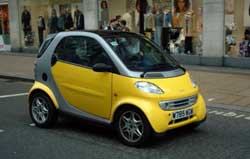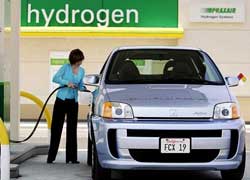Energy Efficient Vehicles
Where would we be without motor vehicles? The modern world relies on automobiles, trucks, buses, and airplanes to move goods and people within countries and all around the globe, for business and for pleasure. Worldwide, transportation accounts for 22% of energy use. Road vehicles—automobiles, trucks, and buses—account for 75% of the energy used for transportation.
|
Cars, buses, and trucks crowd roads around the world, using gasoline and adding pollution emissions to the atmosphere. |
|
Vehicles on the roads use 75% of the energy used by transportation. Reducing their energy use would go a long way to reducing pollution., using gasoline and adding pollution emissions to the atmosphere. |
Almost all motor vehicles are powered by fuel derived from oil, mostly in the form of gasoline or diesel. Motor vehicle fuel is the single biggest use for oil. With all oil come polluting emissions, however. We have known for a long time that motor vehicles are major producers of polluting carbon dioxide (CO2) emissions. Transportation use accounts for 27% of CO2 emissions worldwide.
With all the concern about decreasing CO2 emissions, there has been increased pressure to do something about it. Public transportation, carpooling, and other approaches have been promoted, but most people prefer their own vehicle. This is especially true in places such as China and India, where growing economies are now enabling more people to buy automobiles.
Many countries have instituted antipollution laws to reduce other emissions, such as sulfur oxides (SOx) and nitrogen oxides (NOx), from motor vehicles. These laws have helped decrease smog and other effects of pollution. But only now, with the nearly universal acceptance of global warming as a reality, are we taking other steps to find ways to decrease CO2 emissions. That means driving energy-efficient vehicles that use less oil-based fuel or even alternative fuels that produce few or no emissions. Some energy-efficient vehicles are already on the road—for instance, the gasoline-electric hybrid. Others, such as the electric vehicle, were tried and withdrawn but are going back on the market in the near future, with technological advances. Still others are mostly in the experimental stages—for example, the fuel-cell-powered bus.
How Do We Measure Energy Efficiency in Vehicles?
The basic measurement of fuel efficiency is how many kilometers (miles) a vehicle travels for each liter (gallon) of fuel in its tank. There are a number of factors that can affect the fuel-economy rating of a vehicle. Size and weight are the most obvious ones—smaller, lighter cars can travel a greater distance for each liter of gas, compared with larger, heavier vehicles. The size of the engine also matters: the more powerful, heavier engines use more fuel. Where you drive also makes a difference. Vehicles traveling on highways at higher speeds use less fuel than those traveling on small local roads, where drivers must often stop and start, which uses more fuel. However, the internal combustion engine operates best at an optimal speed of 80-89 km/h (50-55 mph). Thus driving faster than that speed range on the highway uses more fuel.
Fuel Economy Now
One way to increase vehicle energy efficiency and reduce emissions is through better fuel economy. Smaller, lighter cars use less fuel and thus produce fewer emissions. In many countries around the world, small cars are very popular. Auto manufacturers continue to refine fuel efficiency for these markets.
In the United States, drivers long favored bigger sport-utility vehicles, minivans, luxury cars, and pickup trucks. But since 2005, fuel prices have climbed sharply. In response, sales of smaller, more fuel-efficient cars are increasing, while sales of the gas-guzzling sport-utility vehicles and trucks are plummeting. The more fuel-efficient cars from Japanese manufacturers, including Honda, Toyota, and Nissan, dominate car sales in the United States. However, U.S. drivers remain among the biggest users of gasoline in the world.
|
Small automobiles, for example the Mini Cooper, are much more energy efficient than larger vehicles. Concern about pollution and energy efficiency has led to an increase in popularity for this and other small cars. |
|
The tiny smart fortwo, seen here in Oxford, England, is one of the smallest vehicles on the road in North America and Europe. It is very energy-efficient, and easily fits into small parking spaces in crowded cities. |
|
General Motors Chevrolet division is planning to launch the electric Volt model in 2010. This vehicle combines a lithium-ion battery and a gasoline-powered engine to significantly increase energy efficiency. |
|
Many believe that in the future all vehicles will be powered by hydrogen fuel cells, but most are in the experimental stage as of 2009. One issue yet to be resolved is the lack of hydrogen filling stations. |
In Europe, where fuel prices have consistently been much higher than in the United States, smaller cars have always been popular. Top-tier auto manufacturers Mercedes-Benz and BMW make popular small luxury cars. Other popular small cars are made by Opel, Renault, and Volkswagen. U.S. automaker Ford has two of the top ten most popular cars in Europe: the Focus and the smaller Fiesta. Only the Focus is sold in the United States; Ford stopped selling the Fiesta there years ago. While many of the smaller cars popular in Europe never reach the United States, others have found a new market in the United States—for example, the popular Mini Cooper.
One of the smallest cars on the market is the two-seater SmartCar, available in Europe and the United States. Although it meets the stringent U.S. highway safety standards, the SmartCar does not have the power to perform very well on the highway. Its small size and thrifty way with gas makes it useful only for city driving or around-town use.
Small cars are also the biggest sellers elsewhere in the world. In South America, over 50% of the cars sold are small cars. The small car dominates in Asia as well, with many coming from South Korean manufacturers Hyundai and Daewoo. Chinese carmakers are on the rise.
|
|
|
 |
Digging Deeper |
|
|
|
Still, the number of cars on world roads continues to increase, especially in developing countries such as China and India, where more people can now afford cars. Fuel economy helps a little, but it does not solve the problem of CO2 emissions or true energy efficiency. However, there are alternatives that do not produce as much CO2 as combustion-engine vehicles.
Electric Vehicles
The electric vehicle has been in development since the dawn of the automobile age. These vehicles use an electric motor for power and contain batteries that can be recharged by plugging into the electric grid. The electric vehicle also gets some of its power from itself, through a process called regenerative braking. In this type of brake system, the electric motor is reversed and turned into a generator to slow the car. The generator helps recharge the batteries a little (conventional brakes are also needed). Despite its long history, the success of the electric vehicle has been limited by battery technology. The next generation of electric vehicles has been announced for 2009 and 2010.
The Gasoline-Electric Hybrid
The hybrid vehicle combines the power of the combustion engine with an electric motor to increase energy efficiency. There are a number of different ways to combine the two, but all hybrids are able to switch between power sources. This enables the hybrid to use significantly less gasoline, thus reducing CO2 emissions. The hybrid battery is recharged by driving the car, as well as a little from regenerative braking.
Alternatives to Gasoline
Alternative fuel sources are another way to decrease CO2 emissions and to increase energy efficiency. Some alternative fuels are derived from plant products—for example, ethanol and biodiesel. Others are more energy-efficient forms of fossil fuels, including cleaner diesel, compressed natural gas, liquefied natural gas, liquefied petroleum gas (propane), and liquids made from coal, which uses energy in its manufacturing process. One other alternative is the fuel cell. Fuel cells are considered the future of energy for vehicles, but they are still in the earliest testing stages. In addition, right now the hydrogen used to power fuel cells is derived from fossil fuels.
This content has been re-published with permission from SEED. Copyright © 2025 Schlumberger Excellence in Education Development (SEED), Inc.



.jpg?n=9663)



